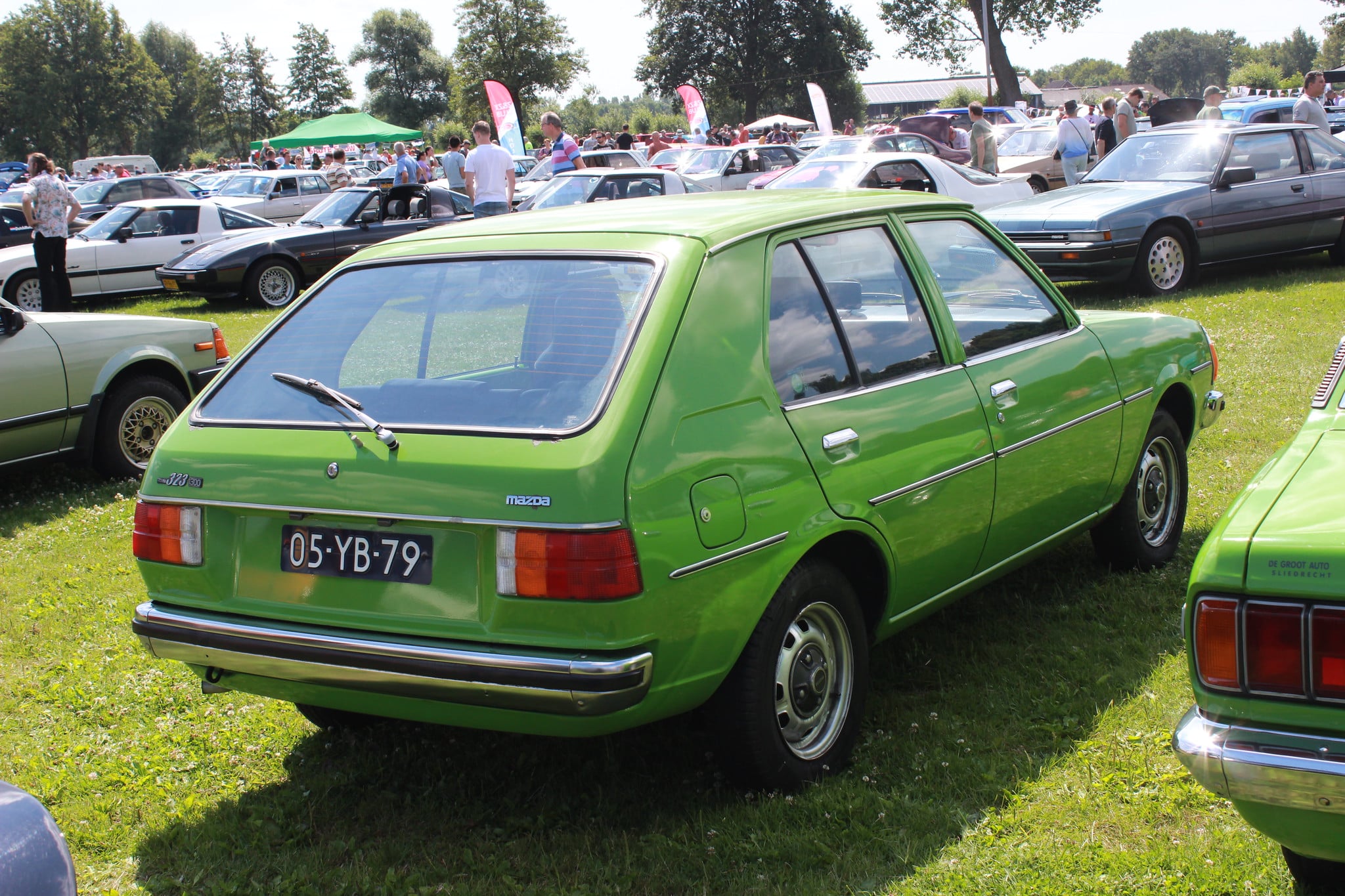When everybody said “Golf!” Mazda brought a new Generation of cars to the world. And it lived until the 1990s in Indonesia.

I am biased when it’s about old Mazdas. And this #Mazda 323 is especially fun, as I own a 626 coupé from the same generation. And with little information, as usual when in comes to bread and butter japanese cars from the 70s, I try to serve as much as possible to the car nerds table. The Mazda 323 generation FA4 actually goes by the name “Familia”. And with that, the genes reach far into Mazda’s history. In the 60s, when Mazda started to build real cars besides three-wheelers (pun intended), the Familia was part of the quasi first generation alongside the Carol. With the FA4, Mazda introduced the 323 designation in most markets outside Japan and Asia – along with a new nomenclature for all Mazdas. The 323 FA4 has an interesting position. On the one hand it continues the RWD tradition, on the other hand it represents it marks a shift in design, „sleeker, more international, less baroque“ as Tumminelli put it in „Car Design Asia“ (pg 136). And just like its bigger brother, it features the sort of sloping grille, that was to be short-lived on both the 626 and the 323 – a facelift follows already in 1979. Under the code X508 Mazda came up with a modern three box design, with which they could play in the Golf class. And despite the rather old-fashioned technical conception, the 323/Familia FA4 became a great success, and together with 626 the 323 will be one of the most successfull cars for Mazda for years to come.


You are stunned by all the green outside? Wait until you see whats going on inside. Mazda were not shy of colors – the chequered seat covers corresponded with the exterior colour. More upmarket modells featured plush seats in different colors. This is a 1300, the 60 PS 1,3 (FA4TS). Enginewise you had the choice between 1.0, 1.3 or 1.4 4 cyl. units – wait until Part 2 of this feature, there was even a funky GTI version called the SP.


 Yes, talking Golf class competetion, we have to talk GTI. Of course, the SP was far away from being the quickest, but it definetely had all the looks. Inside it came with a sportier wheel and a good set of extra gauges – and nope, no fake wooden veneer for the sportier 323 owner. Under the bonnet a 1.4 litre with 70 PS. Outside still steelies but wider dimensions. The SP was only availabe in black and a dark silver tone. Brilliant.
Yes, talking Golf class competetion, we have to talk GTI. Of course, the SP was far away from being the quickest, but it definetely had all the looks. Inside it came with a sportier wheel and a good set of extra gauges – and nope, no fake wooden veneer for the sportier 323 owner. Under the bonnet a 1.4 litre with 70 PS. Outside still steelies but wider dimensions. The SP was only availabe in black and a dark silver tone. Brilliant.


What else? Some pictures show the 3 and 5 door variants in different colors. Take a closer look at the inside. Funky. Let’s look briefly at other markets. It is interesting that the differences to the Familia in Japan were not very big. It had a slightly different grill and, of course, fender mirrors.



You’ve might noticed the absence of driver side mirrors on all brochure shots. In fact importeurs had to source the mirrors – the japanese fender mirrors never made it outdie of Japan. In the UK the mirrors used came from British Leyland.
 Some of the van variants were reserved for the Japanese market. In the US, the 323 was sold under the abbreviation “GLC”, which meant “Great Little Car” – and thus carried the difference to the land yachts common there as a USP. Remember Part 1 of our „Familia“ FA4 journey. This was a huge shift in design for Mazda, that had to explained to the US-buyer. In some ways Mazda just did it like #Austin, when they still were sold in the US, almost synonymously as „small car“. The SP was sold as the “Sport” with typical late 70s decals. The whole production span was from 77 to 80. In only three years, a facelift was introduced already in 79. Just as the /Capella 626 CB, the car got rectangular headlights – and it seems like the funky inside colors were gone.
Some of the van variants were reserved for the Japanese market. In the US, the 323 was sold under the abbreviation “GLC”, which meant “Great Little Car” – and thus carried the difference to the land yachts common there as a USP. Remember Part 1 of our „Familia“ FA4 journey. This was a huge shift in design for Mazda, that had to explained to the US-buyer. In some ways Mazda just did it like #Austin, when they still were sold in the US, almost synonymously as „small car“. The SP was sold as the “Sport” with typical late 70s decals. The whole production span was from 77 to 80. In only three years, a facelift was introduced already in 79. Just as the /Capella 626 CB, the car got rectangular headlights – and it seems like the funky inside colors were gone.


While the Familia/323 BD came in 1980, being a massive success for Mazda, the good ol FA4 was not over. Let’s go over to Indonesia! In the 90s we see the rebirth of a 20-year-old design. The Southeast Asian car market and car production are in themselves an extremely interesting topic. The Indomobil Group has been working on a local produced small car project since the 70s, only lacking resources for design – a deal with Mazda brings the FA4 323 back to life.

Adapted to the 90s, there are plenty of modifications. But the basic shape of the FA4 323/Familia remains recognisable. The front headlights are taken from the 626GC: This is the Mazda MR90. Initially, this stands for “Mobil Rakyat 90”, “Peoples Car 90”. But compared to the top dog on the Indonesian market, the #ToyotaKijang, it is far too expensive. As a result, the name was changed in two curious ways. First to “MisteR Ninety”, so MR90 remains as the abbreviation, and then, watch out, no joke: Mazda Baby Boomer! As a Baby Boomer, the MR90 gets a few more visual changes. And much thanx to Instagram user @alifagta I can show you this car in all its glory! What a wonderfull example. Thanx a lot!



But is that the end of the story? Have a seat! The Indomobil boss Marvy Apandi owned a small company for GFK kit cars, Marvia Graha Motors. In the 90s, VW showed interest in producing Audis in Indonesia but doubts the production quality of Indomobil – Apandi however even considers the production of Porsche 911 possible. There are two versions of the story here. One: Porsche has two 911s built in Indonesia, the other: Marvia is testing the production of headlights and interior parts. Two GRP 911 bodies are built for this purpose. These look so good and real that a production of 50 of these vehicles is started. And the Mazda MR90 serves as the basis. The Marvia Porsche has a 1.4 litre engine in the front – and everything else comes from Mazda. Looking at the GRP body, it seems at least plausible that Marvia must have had original data and dimensions from Porsche. On an Indonesian car blog, there is talk of a lawsuit being sought by Porsche against both Marvia and Mazda. Did it ever come to that? No idea. Already in 1997 Mazda Indonesia Manufacturing is history, just like the production of the strange Mazda 323 FA4 offspring.




Only Fans is in the making. Literally great content!
A website? So I have to follow you on IG, TikTok, Youtube and here.. please don’t tell me you have…
Absolutely, but when I look at all the Pike-Cars, the Pao remains my abolute favourite :)
The Nissan S-Cargo was also quite a neat design from the 90s. 😊